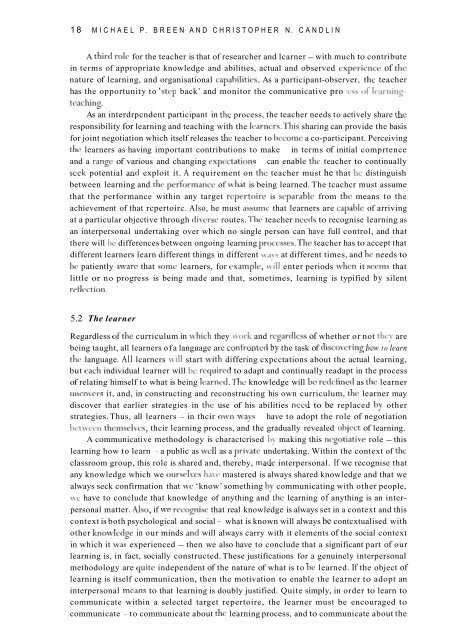Download - Search
Download - Search
Download - Search
You also want an ePaper? Increase the reach of your titles
YUMPU automatically turns print PDFs into web optimized ePapers that Google loves.
in18 MICHAEL P. BREEN AND CHRISTOPHER N. CANDLINA third rolc for the teacher is that of researcher and lcarner - with much to contributein terms of appropriate knowledge and abilities, actual and observed experience of thenature of learning, and organisational capahilitics. As a participant-observer, thc teacherhas the opportunity to ‘stcp back’ and monitor the communicative protcaching.As an interdrpcndent participant in thc process, the teacher needs to actively share theresponsibility for learning and teaching with the 1carncrs.This sharing can provide the basisfor joint negotiation which itself releases thc teacher to become a co-participant. Perceivingthc learners as having important contributions to make in terms of initial comprtenceand a rangc of various and changing expcctations can enable thc teacher to continuallyseek potential antl exploit it. A requirement on the teacher must he that he distinguishbetween learning and thc performancc of Irhat is being learned. The tcachcr must assumethat the performance within any target rcpertoire is separablc from thc means to theachievement of that rcpertoirc. Also, he must assume that learners are capablc of arrivingat a particular objective through tlivcrsc routes. The teacher nccds to recognise learning asan interpersonal undertaking over which no single person can have full control, and thatthere will be differences between ongoing learning processes.The teacher has to accept thatdifferent learners learn different things in different bvays at different times, and he needs tobc patiently awarc that somc learners, for cxamplc, \vi11 enter periods when it swms thatlittle or no progress is being made and that, sometimes, learning is typified by silentrefkction.5.2 The learnerRegardless ofthe curriculum in lvhich they \vork and rcgartllcss of whether or not they arebeing taught, all learners ofa language arc confronted by the task of discovcring how to learnthe language. All lcarncrs \vi11 start with differing cxpcctations about the actual learning,but each individual learner will be required to adapt and continually readapt in the processof relating himself to what is being learned. The knowledge will be redefined as the learneruncovcrs it, and, in constructing and reconstructing his own curriculum, the learner maydiscover that earlier strategies in the use of his abilities need to be replaced hy otherstrategies. Thus, all learners ~ thcir own wys have to adopt the role of negotiationbet>vecn thcmselvcs, thcir learning process, and the gradually revealed object of learning.A communicative methodology is charactcrised by making this ncgotiative role - thislearning how to learn ~ a public as well as a private undertaking. Within the context of theclassroom group, this role is shared and, thereby, made interpersonal. If we recognise thatany knowledge which we ourselws haw mastered is always shared knowledge and that wealways seck confirmation that \vc ‘know’ something by communicating with other people,\re have to conclude that knowledge of anything and thc learning of anything is an interpersonalmatter. Also, if we recognisc that real knowledge is always set in a context and thiscontext is both psychological and social ~ what is known will always be contcxtualised withother knowlcdge in our minds antl will always carry with it elements of the social contextin which it was experienced ~ then we also have to conclude that a significant part of ourlearning is, in fact, socially constructed. These justifications for a genuinely interpersonalmethodology are quite independent of the nature of what is to bc learned. If the object oflearning is itself communication, then the motivation to enable the learner to adopt aninterpersonal means to that learning is doubly justified. Quite simply, in order to learn tocommunicate within a selected target repertoire, the learner must be encouraged tocommunicate ~ to communicate about the learning process, and to communicate about the


